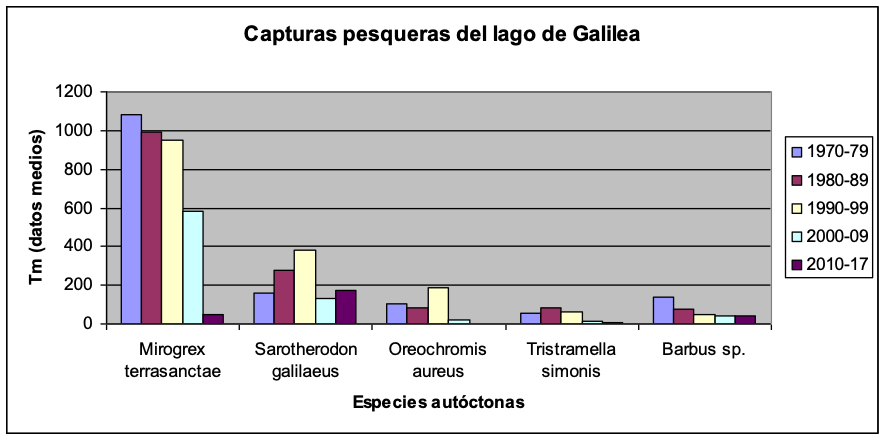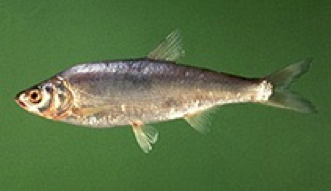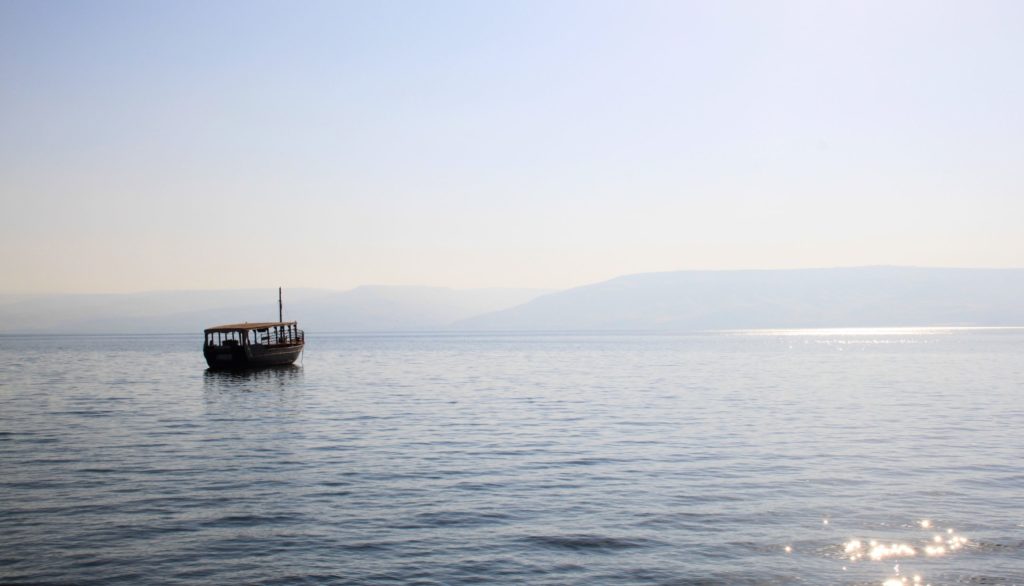The Gospels narrate two miracles of multiplication of loaves and fishes. This text studies the species of fish, the date and the possible places where the first one occurred; in a following text I will refer to the second multiplication.
Our hypothesis is that the first multiplication occurred in the early spring of the year 29, in the present Taghba and Jesus multiplied the sardine from the lake, Mirogrex terraesanctaepreserved in salted fish.
Lake Galilee
We will begin by giving some basic information about the place of the miracle.
The Lake Galilee (also called Lake of Gennesaret, Tiberias or KineretThe lake (see figure 1) is the main freshwater body in northern Israel, and is considered subtropical. The lake is -210 meters below sea level: it is the lowest lake on earth. It is roughly elliptical in shape, and measures 21 kilometers at its longest point in the north-south direction, and 12 kilometers wide in the east-west. Its depth is variable, reaching up to 42 meters. It is crossed by the Jordan River from north to south.
The climate is semi-arid Mediterranean, with 380 mm of rainfall/year on average. The water temperature ranges between 15 and 30º C, and its salinity is 0.27 g/l. The conditions of the lake are very beneficial for a high fish production, and since ancient times it has had a constant fishing exploitation, especially in the northern area, and numerous ports on its shores. In addition, its environment is suitable for agriculture.

The first multiplication
The first multiplication of the loaves and fishes is the only miracle of Jesus reported in the four Gospels. The Lord did it for the Galileans in the area (Mt 14:13-21; Mk 6:30-44; Lk 9:10-17 and Jn 6:1-15).
We quote the version of John, a disciple of Jesus who, besides being the only evangelist who was a fisherman by profession (Mt 4:21; Mk 1:19; Lk 5:10), was most probably present at the miracle: "After this, Jesus went to the other side of the Sea of Galilee (or Tiberias). Many people followed him, because they had seen the signs he did for the sick. Then Jesus went up the mountain and sat there with his disciples. Now the Passover, the feast of the Jews, was near. Jesus then lifted up his eyes, and when he saw that many people were coming, he said to Philip, 'Wherewith shall we buy bread, that these may eat? He said this to test him, for he well knew what he was going to do. Philip answered him, 'Two hundred denarii of bread are not enough to give everyone a piece.
One of his disciples, Andrew, Simon Peter's brother, says to him, 'Here is a boy who has five barley loaves and two fish; but what is that for so many?'" Jesus said, 'Tell the people to sit down on the ground.' There was plenty of grass in that place. They sat down; the men alone numbered about five thousand. Jesus took the loaves, said the thanksgiving, and distributed them to those who were sitting down, and likewise as much as they wanted of the fish.
When they had eaten their fill, he says to his disciples, 'Gather up the pieces that are left over; let nothing be lost.' They gathered them up and filled twelve baskets with the pieces of the five barley loaves that were left over from those who had eaten. The people then, when they saw the sign that he had done, said, 'This is truly the Prophet who is to come into the world.' Jesus, knowing that they were going to take him away to proclaim him king, withdrew again to the mountain by himself."
Place of the first multiplication
The place where the first multiplication of the loaves and fishes occurred has been discussed by specialists, since neither the location of the ancient city of Bethsaida, near which the miracle took place according to the Gospel of Luke, is clear, nor are the narratives of the four evangelists in complete agreement.
Among the various opinions, we are inclined to the one by Baldi (1960) y Pixner (1992), which situate the site in the present-day Tabghabased on a tradition consistent with some of the Gospel accounts (Figure 1).
The main argument is the written testimony of the Spanish pilgrim woman Egeriaat the end of the fourth century. She cites a stone, already venerated by the first Christians, on which the Lord would have rested the food: "Not far from there [Capernaum] you see the stone steps on which the Lord stood. Right there, above the sea, there is a field covered with grass, with plenty of hay and many palm trees, and beside those, seven springs, each of which provides abundant water. In that meadow the Lord satisfied the people with five loaves and two fish. It is good to know that the stone, on which the Lord placed the bread, has now become an altar".
Tabgha means "seven fountains", some of which are still preserved today. It is necessary to consider that the one of Egeria would be one of the first pilgrims to the Holy Land, since until 313 and the peace of Constantine, Christianity was forbidden in the Roman Empire.
In addition, there are archaeological remains that demonstrate the presence of a church in this place in the fourth century. Pixner (1992), well acquainted with the geography of the place, gives a further argument in favor of this location.
He explains that the Gospel of Mark (6:31-33) describes that the crowd fed in the miracle arrived at the place before Jesus. They followed him on land while Jesus went by boat with his disciples "seeking a secluded place" in which to rest. In spring the Jordan is very high, and difficult to ford quickly. Therefore, the area of the miracle must have been close to the main towns in the area, Capernaum, Chorazin and Ginnosaras in the case of Tabgha.
Today there is a Byzantine church in this place where the miracle is commemorated, and which preserves a stone that could be the one described by Egeria, and a Byzantine mosaic of the sixth century alluding to it (figure 2).

Multiplied fish species
To make a hypothesis regarding the species used by Jesus in the first multiplication of loaves and fishes, we start from the current fishing data of the Lake of Galilee and from the data of the Gospels. Among the current fish species, allochthonous species must be ruled out. There is evidence of the introduction of some foreign species of mugilids in 1958, of silver carp, and of the introduction of some other species of fishes. Hypophthalmicthys molitrix in 1969 and common carp Cyprinus carpio.
Moreover, it is certain that the Jews would not eat species present in the lake but considered impure by the Old Testament (Lev 11:9-12), such as eels and silurids, which have no scales (properly speaking, the scales of eels are microscopic).
If we discard the species of no fishing interest, six species remain (Figure 3): Sarotherodon galilaeus (Linnaeus, 1758) or Tilapia mango, Oreochromis aureus (Steindachner, 1864) or St. Peter's fish, Tristramella simonis simonis (Günther, 1864), the barbels Barbus longiceps (Valenciennes, 1842), y Carasobarbus canis (Valenciennes, 1842) (grouped in the graph as Barbus sp.) and Mirogrex terraesanctae (Steinitz, 1952) or Lake Galilee sardine.

If we take the original Greek text of John's narrative, it uses the word opsaria (John 6, 9 of the original Greek, small fish) instead of ichthyes (fish). This word comes from optos, which means food seasoning and is used especially for salted and dried fish. Of the six species considered, only one is small in size in the adult state, the lake sardine Mirogrex terraesanctae (Figure 4).
It is a pelagic fish that lives near the surface of the lake water in large schools, and is about 14 centimeters long on average (fishbase.org). It is a native and endemic species of the lake, as expressed in the word "endemic". terraesanctae, which translated from Latin means "from the holy land", from the country sanctified by Jesus.
Although our reasoning is not conclusive regarding this species, we assume that it is the species used in the miracle, rather than juveniles of the other species. There are several reasons for this.
The use of this salted species as a regular food for the population is documented, as it was fished seasonally and in large quantities, up to 10 mt daily, the sardine was salted. In addition, there are archaeological remains of the salting industry in Magdala, a city south of Tabgha.
Finally, in practice it would be complex to feed fresh fish to such a large number of people, because it would be very difficult in a deserted place like the one described by the Gospels to make a large number of fires to roast so many fish.
At present, sardine catches have decreased radically, not because the resource has disappeared, but due to the lack of profitability of the purse seine fishing fleet, the main way of catching this species, which has practically disappeared, with only one boat remaining at present.

Date of the miracle
It is John's account that specifies that the miracle happened before the second Passover of Jesus' public life (the Passover is celebrated on the first full moon of spring, in March-April), and that probably places it in spring of the year 29 of our era, one year before his death.
Priest and Doctor in Theology and Marine Sciences.








